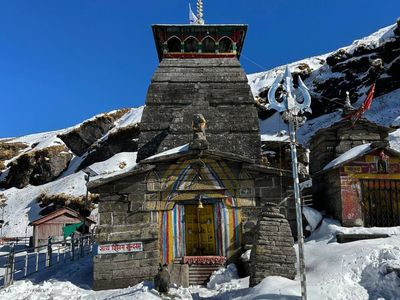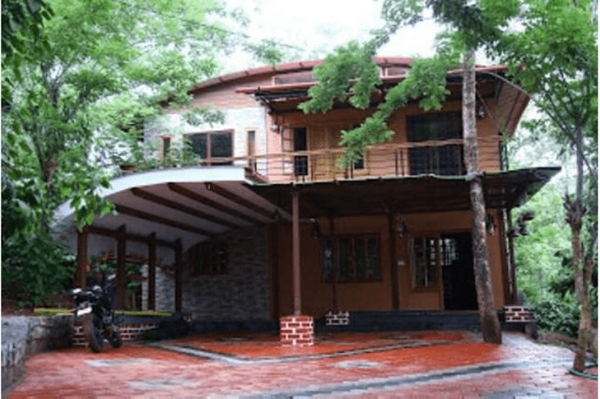The Legend of Panch Kedar: Lord Shiva’s Disguises in the Himalayas
 Mountains Curve
25 Feb, 2025
10 mins read
75
Mountains Curve
25 Feb, 2025
10 mins read
75

The Himalayas, with their majestic peaks, dense forests, and spiritual serenity, have long been a place of worship and pilgrimage for countless devotees. Among the many sacred sites that dot this incredible range, there’s one journey that stands out for its blend of spirituality, adventure, and mythological intrigue: the Panch Kedar Yatra.

Panch Kedar Trek - Madhmaheshwar Temple
This awe-inspiring trek takes you through five ancient temples dedicated to Lord Shiva, each one representing a different part of his divine form. The trek weaves together not only breathtaking views of the Garhwal region but also the rich mythological stories of the great Mahabharata. If you're a travel enthusiast, adventure seeker, or a devotee of Lord Shiva, the Panch Kedar Yatra is a journey of a lifetime one that blends physical challenge with spiritual awakening, where every step leads you closer to both nature’s beauty and the divine.
The Mythological Heartbeat of the Panch Kedar Yatra
The legend behind the Panch Kedar Trek is one that transcends time, echoing the grandeur and mystique of the Mahabharata. According to the ancient texts, after the great war of Kurukshetra, the Pandavas were filled with guilt over the bloodshed and sought atonement. The one they turned to for forgiveness was Lord Shiva. However, in his divine wisdom, Lord Shiva decided to evade them.
To escape, he transformed himself into a buffalo and tried to disappear into the earth. Yet, the Pandavas, led by the mighty Bhima, discovered his true identity. To avoid their presence, Shiva dived underground, and his body was believed to have appeared in five different locations across the Himalayas. These five spots became the sacred temples of Panch Kedar.
Each temple corresponds to a different part of Lord Shiva’s body:
- Kedarnath symbolizes his hump,
- Madhmaheshwar represents his navel,
- Tungnath symbolizes his arms,
- Rudranath depicts his face,
- Kalpeshwar signifies his hair (jata).
This mythical connection makes the Panch Kedar Trek not only a journey through the serene and breathtaking landscapes of Uttarakhand but also a deeply spiritual odyssey.
A Spiritual and Physical Adventure
The Panch Kedar Yatra is not for the faint-hearted, but it is a trek that rewards its participants with stunning views, spiritual solace, and a deep connection to the natural world. The trek itself spans across 95 kilometers (59 miles) and typically takes 10-11 days to complete. Along the way, trekkers pass through lush forests, alpine meadows, and quaint Himalayan villages, all while being surrounded by the majestic peaks of the Garhwal Himalayas.
If you are seeking more than just a regular hiking experience, Panch Kedar Yatra offers you an unparalleled opportunity to delve into the mysteries of both nature and spirituality. The physical challenge of trekking at high altitudes is balanced by the serenity that these sacred temples offer, creating the perfect blend for those seeking adventure and inner peace.
The Temples of Panch Kedar
Kalpeshwar: The Sacred Beginning
Your pilgrimage begins at Kalpeshwar, the first temple on the route. Kalpeshwar is nestled in the lush forests of the Garhwal region, and the journey to reach it by road offers stunning views of snow-capped peaks like Nanda Ghunti and Trishul. As you stand before this serene temple, the atmosphere is filled with a deep sense of tranquility. The sound of the river flowing nearby and the cool mountain breeze heighten the feeling of spiritual connection, making Kalpeshwar a perfect place for meditation.
Rudranath: The Face of Shiva
Next, the trek takes you to Rudranath, a temple perched at an impressive altitude, surrounded by verdant meadows and forests. The journey to Rudranath starts from Sagar Village and takes trekkers through dense woodlands and alpine meadows, offering panoramic views of the surrounding peaks. The temple, set in a peaceful environment, is believed to represent the face of Lord Shiva. Surrounded by untouched nature and dramatic landscapes, Rudranath offers a spiritual experience unlike any other.
Tungnath: The Highest Shiva Temple
The Tungnath Temple, situated at an altitude of 12,073 feet, is considered the highest of the Panch Kedar temples. The trek to this ancient shrine begins at Chopta, often referred to as the "Mini Switzerland of India," known for its verdant meadows and rhododendron forests. While the trek to Tungnath is relatively short, it is steep, making it a thrilling adventure. Upon reaching the temple, the views from the summit are nothing short of breathtaking. The temple, believed to represent the arms of Lord Shiva, offers spectacular 360-degree vistas of the Himalayan ranges, including Nanda Devi, Trishul, and Chaukhamba.
The trek doesn’t end here many trekkers choose to continue to Chandrashila, a peak situated above Tungnath, offering some of the most mesmerizing sunrise and sunset views in the region.
Madhmaheshwar: The Navel of Shiva
The Madhmaheshwar Temple is located in a tranquil valley near the Ransi Village, and the trek here is relatively serene, with peaceful forest walks and glimpses of the stunning peaks of Kedarnath and Chaukhamba. The temple is said to represent the navel of Lord Shiva. As you ascend through lush meadows and dense oak forests, you’ll be rewarded with captivating views of the Himalayas, making the journey to Madhmaheshwar a peaceful and soul-refreshing experience.
Kedarnath: The Heart of the Yatra
The final stop on the Panch Kedar Trek is the Kedarnath Temple, one of the holiest sites in Hinduism. The trek to Kedarnath starts at Gaurikund, and the 16-kilometer journey is both challenging and mesmerizing. As you trek through dense forests, past gushing waterfalls and rocky terrain, the imposing Kedarnath Peak gradually emerges in the distance. The temple, built with massive stone slabs, stands resilient against time and is an awe-inspiring sight.
Kedarnath is not only part of the Chota Char Dham Yatra, but it is also one of the 12 Jyotirlingas of Lord Shiva, making it a major pilgrimage site for devotees. Standing at the temple’s entrance, surrounded by the towering peaks, you’ll feel a deep spiritual connection to the divine.
The Best Time for the Panch Kedar Yatra
The ideal time to undertake the Panch Kedar Trek is between May and June and September and October. During these months, the weather is most favorable for trekking, with pleasant temperatures and clear skies offering stunning views of the Himalayan range. May and June offer comfortable conditions for trekking, while September and October bring crystal-clear skies and the chance to witness the grandeur of the Himalayan peaks.
Conclusion
The Panch Kedar Yatra is more than just a trek; it’s a journey through the heart of the Himalayas and into the divine. With its rich mythology, breathtaking landscapes, and spiritual significance, the trek offers a unique opportunity to connect with Lord Shiva and experience the serenity of the mountains. Whether you are a devotee seeking spiritual solace or an adventurer looking for an unforgettable challenge, the Panch Kedar Yatra offers something for everyone.
Written By:
Mountains Curve



Hotels at your convenience
Now choose your stay according to your preference. From finding a place for your dream destination or a mere weekend getaway to business accommodations or brief stay, we have got you covered. Explore hotels as per your mood.





